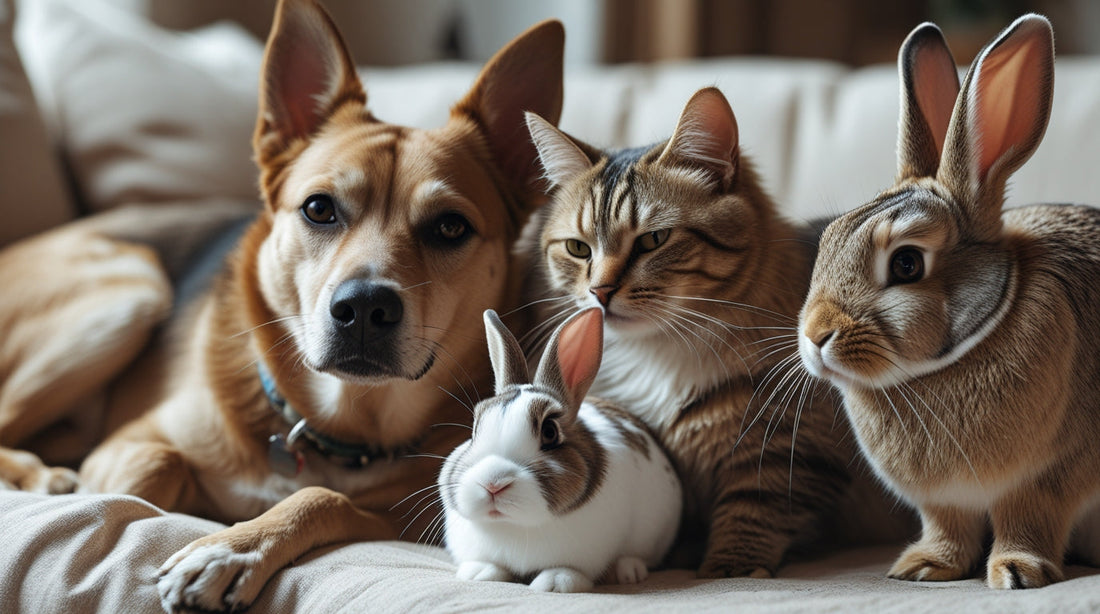Your Pet Speaks… But You Don’t Speak Their Language (Yet)
Your Pet Is Talking to You
Have you ever wondered what your pet is trying to tell you? From the wag of a tail to a quiet purr, our furry friends communicate all day long — even without words. The secret is learning to understand their unique language.
In this blog, we’ll explore how dogs, cats, rabbits, and other pets express themselves through body language, sounds, and behavior. By paying attention to these signs, you’ll build a stronger, happier relationship with your beloved companion.
The Silent Language of Animals

Animals may not speak with words like humans do, but their ways of communicating are just as powerful — if not more. From a simple wag of a tail to a subtle change in posture, every movement and sound your pet makes is full of meaning.
Dogs, cats, rabbits, birds, and other pets rely heavily on body language and vocalizations to express their feelings and needs. For example, a dog might lower its ears and tuck its tail when scared, while a cat might slowly blink to show trust and affection.
Learning to understand this silent language is essential for every pet owner. It allows you to recognize when your pet is happy, anxious, confused, or in pain — often before they show obvious signs. By tuning into these signals, you not only improve your pet’s wellbeing but also deepen the bond between you.
The great news is that you don’t need to be an expert or have special training to start understanding your pet’s communication. It only takes observation, patience, and a willingness to learn.
In the following sections, we will explore the most common signs and behaviors in dogs, cats, and small animals. This way, you’ll begin to unlock the secrets your pet has been “telling” you all along.
Common Signs in Dogs, Cats, and Small Pets
Each type of pet has its own unique ways of expressing feelings and needs. By learning these common signs, you’ll be better equipped to understand your furry friend.
🐶 Dogs: Tail, Ears, Eyes, and Body Posture
Dogs communicate a lot through their body language. Here are some key signals to watch for:
Tail wagging: Not always a sign of happiness. A loose wag usually means a relaxed, friendly dog, but a stiff wag can signal alertness or agitation.
Ears position: Perked up ears usually show curiosity or excitement, while flattened ears can mean fear or submission.
Eyes: Soft, blinking eyes mean calmness; wide eyes with visible whites (“whale eye”) often mean stress or fear.
Body posture: A relaxed dog will have a loose body, while a tense, stiff body can signal discomfort or aggression.
Vocalizations: Barking, whining, growling, and howling all carry different meanings depending on context.
Barking Can mean excitement, alert, attention-seeking, or warning. The tone and pitch give clues — high-pitched barks often mean playfulness or alertness, while deep, slow barks can signal warning or territorial behavior.
Whining Usually indicates discomfort, anxiety, or a desire for attention or help. Puppies often whine to communicate needs.
Growling Typically a warning sign that the dog feels threatened, scared, or is asserting dominance. However, some dogs growl playfully during games — context matters.
Howling This is often a long-distance call to communicate with other dogs or express loneliness. It can also be triggered by certain sounds like sirens or music.
🐱 Cats: Tail, Eyes, Ears, and Vocal Sounds
Cats use subtle body language that can be tricky but rewarding to learn:
Tail movements: A slow, gentle swish shows contentment; a twitching or thumping tail can signal irritation or excitement.
Eyes: Slow blinking is a sign of trust and affection. Dilated pupils may indicate excitement or fear.
Ears: Forward ears mean interest; flattened ears show fear or aggression.
Vocalizations: Meows can mean many things—from greetings to requests; purring usually indicates contentment but can also happen when the cat is stressed.
Meowing Often used to get your attention. It can mean a greeting, a request for food, wanting to play, or even discomfort. The tone, length, and frequency can help you understand what your cat wants.
Purring Usually a sign of contentment and relaxation, but cats can also purr when they are stressed, in pain, or seeking comfort.
Hissing or growling Clear signs of fear, anger, or feeling threatened.
Chirping or chattering Often happens when cats watch birds or prey outside. It may express excitement or frustration.
🐰 Rabbits and Small Pets: Body Language and Sounds
Smaller pets like rabbits have their own ways to communicate:
Stillness: Freezing or remaining very still can indicate fear.
Thumping: Rabbits thump their back feet to warn of danger or express irritation.
Teeth grinding: A soft grind usually means contentment, but loud grinding can signal pain.
Posture: A relaxed rabbit will lie down with legs stretched out; a tense posture means alertness or stress.
What Your Pet Might Be Saying (And You Don’t Know It)
Sometimes, pets use signals that humans often misinterpret or completely miss. Recognizing these signs can help you respond better and strengthen your bond.
Stress signals: Yawning, lip licking, or turning the head away in dogs can mean they feel stressed, not tired or disinterested. Cats may hide or flick their tails quickly when anxious.
Signs of pain: Limping, sudden changes in behavior, or reluctance to move may indicate discomfort. Rabbits grinding their teeth loudly could be in pain.
Expressions of joy: A relaxed body, playful behavior, or “slow blinking” in cats are ways pets show they’re happy and comfortable.
Seeking attention: Dogs might paw at you gently; cats might rub against your legs. Recognizing these cues means you can better meet their needs.
By tuning in to these subtle cues, you become the attentive, caring human your pet needs — someone who understands and respects their unique language.
Become the Human Your Pet Needs

Understanding your pet’s silent language is one of the greatest gifts you can give them. It shows love, respect, and care beyond words.
Remember, every tail wag, purr, twitch, or blink is your pet’s way of talking to you. The more you observe and listen, the deeper your bond will grow — creating a happy, trusting relationship that lasts a lifetime.
So take a moment today: watch your pet closely, try to “hear” what they’re saying without words, and enjoy the amazing connection that follows.
Because when you truly understand your pet, you’re not just their owner — you’re their best friend.

We’d Love to Hear From You!
Have you noticed your pet “talking” to you in ways others might miss? What’s the most surprising thing you’ve learned about your furry friend’s language?
Share your stories, questions, or favorite pet signals in the comments below — let’s create a community of pet lovers who truly understand their companions.
Your insights might just help someone else build a stronger bond with their pet, too!






